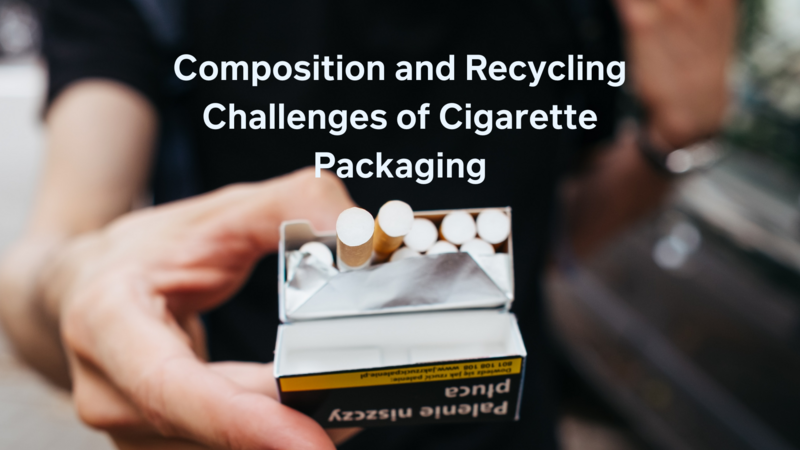Composition and Recycling Challenges of Cigarette Packaging
The urgent need to address environmental concerns has brought the spotlight onto a less discussed yet significant issue: cigarette product packaging and recycling challenges. The world of cigarette packaging recycling is fraught with complexities. The typical packaging of cigarettes, consisting of cardboard, protective liners, and plastic films, poses a challenge in recycling efforts.
However, the key to untangling this challenge lies significantly within the realm of consumer education and behavior.
The Complexity of Cigarette Packaging
Standard cigarette packaging often includes different materials like cardboard, paper liners, tin foil, and plastic film. This combination of materials complicates the recycling process. For example, while the plastic film in these packages is predominantly recyclable, it is often contaminated with colors, adhesives, and other components that hinder proper recycling.
The German company Reemtsma Cigarettenfabriken GmbH is one of the largest tobacco manufacturers in Europe and is known for producing a wide range of tobacco products, including cigarettes. Reemtsma claims, "The packaging of a standard box of our JPS brand containing 20 pieces is 91 percent recyclable. The non-recyclable portion of the packaging, which accounts for nine percent, primarily consists of three component groups:
- Colors and adhesives in the upper part of the plastic foil
- Colors, varnishes, and adhesives that hold the folding box cardboard together
- The lower part of the plastic foil, which unfortunately is not regularly removed ends up in the wrong recycling system along with the folding box cardboard." (Source: Reemtsma)
Many smokers may not be aware that elements of their cigarette packaging, particularly the plastic film, are recyclable. Educating consumers to separate these materials – the cardboard, the plastic film, and the Inner Liner – can significantly impact the recycling process. Actions as simple as removing and separately disposing of the plastic film can substantially improve recycling efficiency.
Contamination remains a major barrier in the recycling of cigarette packaging. Tobacco residues, adhesives, and mixed materials often result in consumers disposing of the entire package as general waste. Raising awareness about these contaminants and how they can be avoided is essential in enhancing recycling rates.
Effective recycling of cigarette packaging demands a collaborative approach between the tobacco industry and consumers. Consumers must modify their disposal habits while the industry focuses on integrating recyclable materials. This partnership can significantly improve recycling rates and overall environmental sustainability. Addressing the recycling challenges of cigarette packaging requires a dual approach: industry innovation in packaging design and consumer education in proper disposal practices. By understanding and acting on these aspects, consumers can play a critical role in enhancing the recycling of cigarette packages, thereby contributing to a more sustainable environment.
The recycling of cigarette packaging is not only a matter of material composition and consumer behavior but is also deeply influenced by legislation and industry standards.
Governments worldwide are increasingly focusing on environmental issues, imposing regulations that mandate the use of recyclable materials and penalize non-compliance. These laws compel tobacco companies to innovate in packaging design, moving towards materials that are easier to recycle and have a smaller environmental footprint.
Many tobacco companies must align with global sustainability goals in response to legislative pressures and growing environmental consciousness. For instance, leading companies in the sector, like those associated with Innovia Films Ltd, adhere to Science-Based Targets, a framework that defines how much and how quickly they need to reduce their greenhouse gas emissions. This commitment extends to packaging, aiming for a low carbon footprint while maintaining product integrity.
A significant trend influenced by legislation and industry standards is the shift towards a circular economy in packaging. This approach emphasizes reducing, reusing, and recycling materials to keep resources in use for as long as possible. For cigarette packaging, this means evolving towards designs that can be easily recycled and made from materials with less environmental impact. For example, the transition to mono materials like polypropylene (PP) in packaging, as opposed to composite materials, is gaining momentum due to its higher recyclability.
Despite these efforts, the tobacco industry faces challenges in fully adopting sustainable packaging. The need for packaging that provides adequate protection, longevity, and brand representation often conflicts with environmental objectives. Balancing these aspects while adhering to regulatory demands is a complex yet essential task.
Emerging trends and innovations promise to revolutionize how the tobacco industry approaches sustainability and recyclability in packaging.
The future of cigarette packaging lies in developing innovative materials that are both sustainable and functional. Companies are exploring options beyond traditional plastics, such as biodegradable and compostable materials. While these alternatives present their own set of challenges, including cost and the need for specific recycling facilities, they represent a significant step towards a more sustainable future.
Collaboration between companies, packaging manufacturers, recycling facilities, and policymakers will be essential. Joint efforts can lead to developing standardized, recyclable packaging solutions that meet consumer needs and environmental goals. As new materials and technologies emerge, coupled with increased consumer awareness and stricter regulations, the tobacco industry is poised to make significant strides in sustainability. The journey towards more recyclable and environmentally friendly packaging is ongoing, but the direction and commitment are clear.


